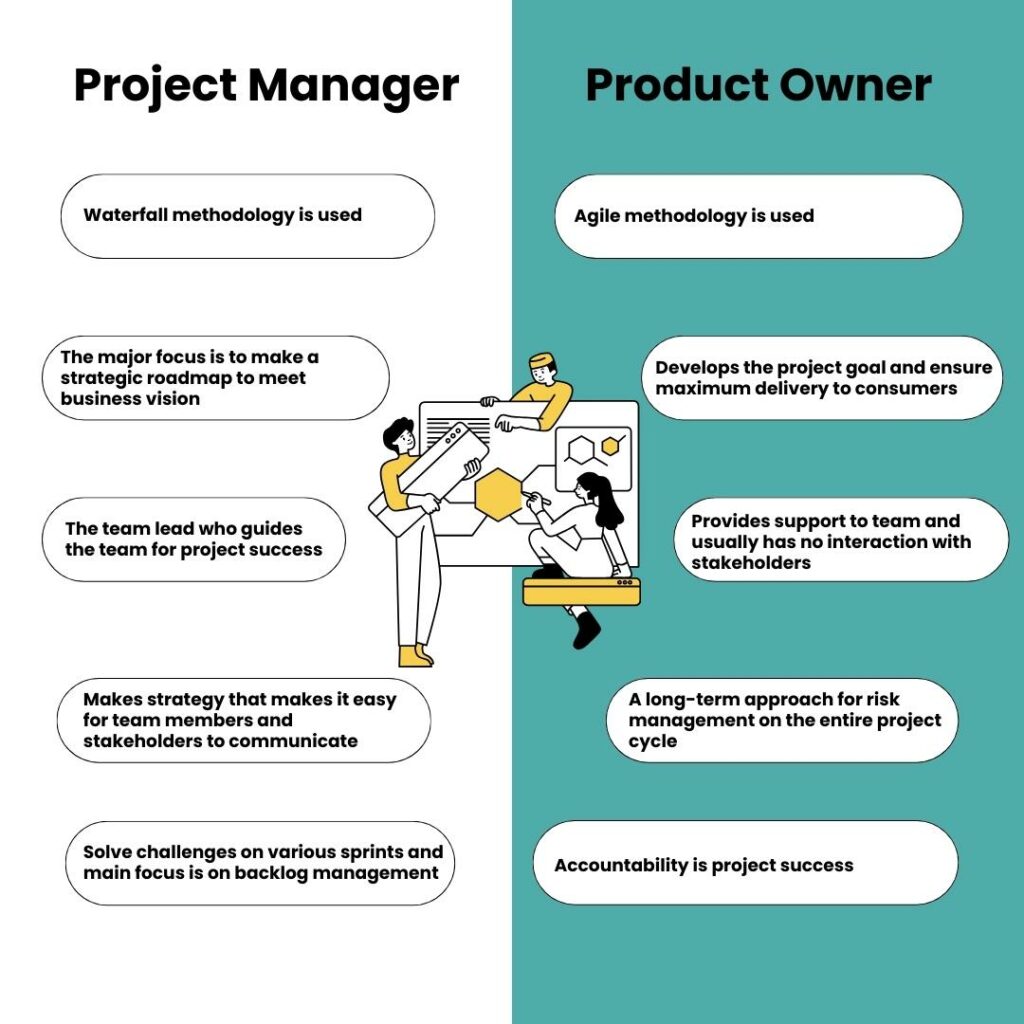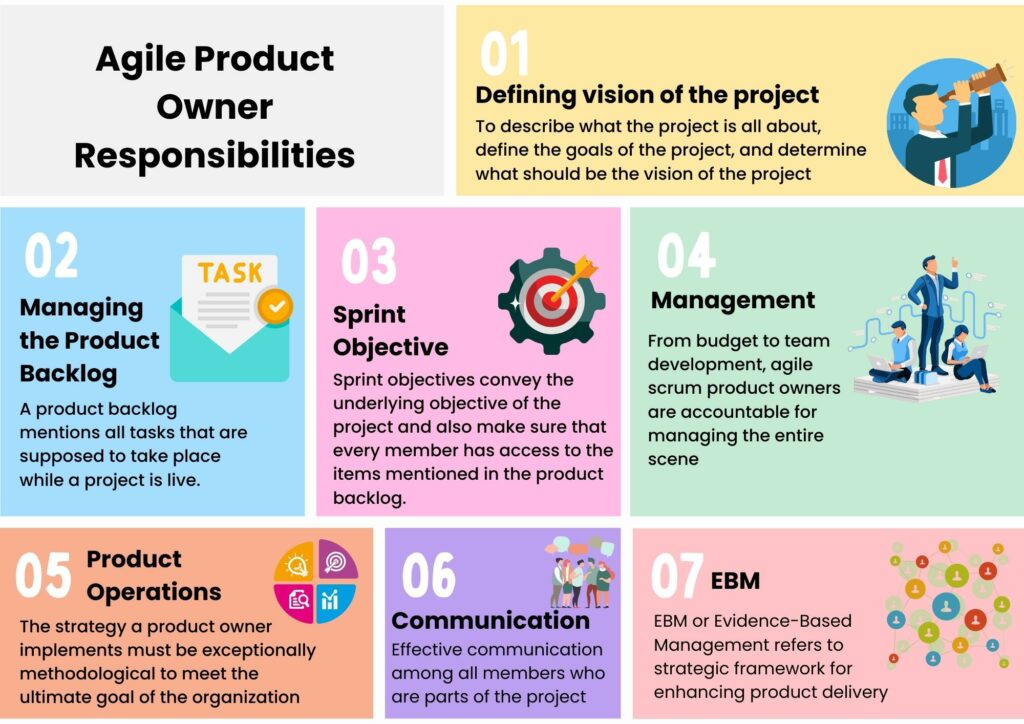Table of Contents
ToggleThere are tons of products and services that businesses offer globally, but do you know what a product owner is? In Scrum methodologies, a key user of the team takes product ownership and works closely with the team. One of the most critical types of software development, Scrum uses advanced techniques for an incremental approach to software development The Product Owner defines user stories based on the needs and satisfaction of consumers and prioritizes those requirements for the development team. A product owner must have a Scrum Master certification and that individual must be aware of product goals, business objectives, and strategies that must be implemented to make a project successful.
In this blog, we will discuss how product owners fulfill their responsibilities using scrum and agile methodologies. If you’re a professional who’s looking for upskilling in a Scrum Master Certification, then please read this blog now to receive all the information about every professional training course for career advancement.
Project Manager Vs Product Owner
A project manager and a product owner are distinct roles within an organization, each with unique responsibilities.

A project manager’s main responsibility is to oversee the planning, execution, and successful completion of projects. This also includes managing resources, timelines, and budgets, and ensuring project objectives align with the goal of the organization. Project managers are associated with the overall project delivery.
On the other hand, a product owner is responsible for optimizing and managing the product backlog representing the interests of end-users and stakeholders. They collaborate closely with the agile teams, guiding feature prioritization and ensuring the product aligns with the organization’s vision and objectives. Product owners focus more on defining product features, functionality, and their alignment with market demands.
Primary Responsibilities of a Product Owner
1. Product Vision & Information
The first step that a Scrum product owner should take is clearly defining the product vision. They have to inform the stakeholders and team members about the strategy to be followed regarding the product. Gathering knowledge and data on the target audience, customer behavior, market trends, etc., are the major duties of a product owner.
2. Product Backlog Management
The product backlog, a constantly changing list of features, improvements, and fixes, is the responsibility of the Scrum product owner. They work with stakeholders to collect requirements and comments, ensuring the backlog is current and reflects the product’s changing requirements. Our training course on product ownership in Scrum can offer business-critical insights into how you can manage the product backlog.
3. Sprint Planning
Sprints are tasks that should be completed within 3-4 weeks, and a product owner is responsible for participating in sprint planning meetings. They have to work closely with the development team to identify and discuss the user stories. They also discuss the upcoming tasks falling under the project. The Product Owner provides clarifications and ensures the team understands the requirements and goals for the sprint.
4. Defining the Acceptance Criteria
Another crucial job of the product owner is to define the acceptance criteria for all the user stories. This involves identifying and finalizing the criteria and conditions that need to be met for the user stories to be completed.
5. Sprint Review
At the end of each sprint, the scrum Product Owner leads the sprint review meeting, where the development team presents the completed work to stakeholders. The Product Owner demonstrates the product increments and gathers feedback, which helps to validate and refine the product direction.
6. Release Planning
The development team releases the product increments in collaboration with the product owner. They determine the adequate features to be added to the release based on the market value and consumer behavior. The scrum product owner takes care of timely product delivery for enhanced and positive results.
Agile Scrum Product Owner Responsibilities
Agile product owners assume a central role in ensuring that the product under development aligns with customer needs, delivers value, and stays in sync with the overarching business strategy. Their duties necessitate ongoing collaboration with the product development team, prioritization and understanding of the project, and adaptability to deliver a successful product incrementally.

A question often comes up what is a strategy a product owner uses? The following are the roles of agile scrum product owners and based on these they offer a fruitful project plan:
1. Defining the Vision of the Project
A product owner’s integral task is to describe what the project is all about, define the goals of the project, and determine what should be the vision of the project. Product owners liaise with stakeholders like customers, business analysts, managers, etc. Their main agenda is to make sure that the understanding of the project is crystal clear. Once the team members get a clear picture of the objective of the project, it becomes easier for the Agile Scrum product owner to chalk out the best strategies to land a successful project.
2. Managing the Product Backlog
Each project includes multiple steps that are usually done in chronological order. However, due to the arrival of sudden unplanned scenarios, product owners may have to de-route the roadmap. A product backlog mentions all tasks that are supposed to take place while a project is live. Prioritizing every step and placing them in positions as the project requires is under the responsibility of the product owner. This product backlog is dynamic and often keeps evolving as the project cycle progresses. The product backlog should be made accessible to all the stakeholders and developers for superior performance.
3. Sprint Objective
In Scrum methodology for Agile, the product owners always set clear objectives before a project goes live. These objectives are usually in one or two statements where the product owners and the delivery team collaborate and prepare. Sprint objectives convey the underlying objective of the project and also make sure that every member has access to the items mentioned in the product backlog.
4. Management
From budget to team development, agile scrum product owners are accountable for managing the entire scene. Money management is one of their crucial responsibilities and taking care of scope, releases, and stakeholders also needs a product owner’s supervision. Besides, they collaborate with the development team regularly to answer their queries and questions to understand the point of view of the customers. This enables a smooth functionality of the project and delivers on time matching the expectations of customers.
5. Product Operations
A certified scrum product owner should have high-level knowledge of product operations as well. The strategy a product owner implements must be exceptionally methodological to meet the ultimate goal of the organization. The main segment of the operations revolves around sharing data and resources among teams that are actively involved in the project. Product Owners may choose to execute their responsibilities to operations, finance, market research, marketing sales, or development teams but are still held accountable for their actions and overall successful product.
6. Communication and Collaboration
One of the most essential pillars of the product development process is communication and collaboration with teammates. Product Backlog Refinement is a concept that product owners, managers, the development team, and the delivery team constantly update and prioritize the roadmap of the project. This is done before planning sprint objectives and mainly it is done to enhance the quality of the project to make sure that items present in the product backlog are executed methodically.
7. Evidence-Based Management
Evidence-based management serves as a strategic framework that empowers enterprises to assess, oversee, and enhance the returns generated from their product delivery endeavors. It places a strong emphasis on optimizing results, mitigating risks, and optimizing value creation. The utilization of EBM by the Product Owner is highly advisable, as it provides organizations with invaluable guidance in making informed investment choices in the most judicious areas. Furthermore, it facilitates informed decision-making and risk reduction through the application of an iterative and incremental approach.
Best practices followed by a Product Owner
Working as a product owner can be challenging, especially in this fast-paced world. Proper strategies and practices ensure that your objectives are achieved.
1. Clear Communication
Proper communication can go a long way. You can’t reach your goals without clearly emphasizing and sharing the objectives and plan of action. As a product owner, you must be crystal clear while communicating the tasks to the team and updates to stakeholders. You are expected to communicate effectively so the project is completed on time with the expected results.
2. Timely Updates
Keeping the stakeholders in the loop saves you from unnecessary troubles and ensures that everybody is on the same page. Product Owners should foster strong relationships with stakeholders, seeking their input and involvement throughout the project. Regularly gathering feedback and involving stakeholders in sprint reviews and product demonstrations increases transparency and ensures that the product meets their expectations.
3. Stress Management
As a scrum product owner, you will be working on different things simultaneously. You also have to move back and forth with the team and stakeholders. You should be able to manage your stress to survive in a stressful environment seamlessly.
4. Set Your Priorities
Multitasking is a desirable skill, but you should have a sense of determining the urgent tasks that need your prior attention. Product owners should identify the priorities and assign work accordingly to the team.
Conclusion
The roles and responsibilities of a product owner are quite impactful and have always laid impeccable results on successful projects. Every business look for skilled agile scrum owners who are capable enough to deal with projects in different domains.
Agile principles and the Scrum framework are highly sought-after skills in the job market. Product owners play a key role in the proper implementation of this methodology and ensure that the projects are efficiently completed in their organization. Check out our Agile Scrum Product Owner training, CSPO training, and PSPO training offered by global governing bodies such as EXIN, Scrum Alliance, and Scrum.org to understand the roles and responsibilities of a Product Owner. At Spoclearn, we offer Agile and Scrum certification course modules taught by industry experts with years of experience in the field.
